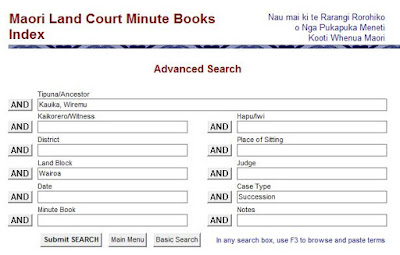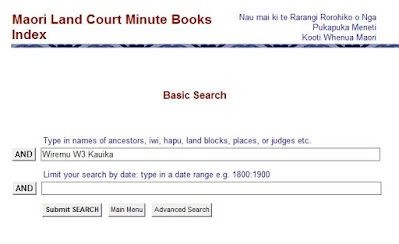Māori Land Court Minute Books - Part 2
 |
| Image: An old institution: the first Land Court building erected in New Zealand, built at Hokianga. Sir George Grey Special Collections, Auckland Libraries, AWNS-19070502-2-4 |
To search the minute books you will need to use the Māori Land Court Minute Book Index. This index was created in the 1990s by librarians at the University of Auckland. The index covers 1,100 minute books from the whole country for hearings held between 1865-1910.
The index is available via two platforms. Either through Knowledge Basket, which Auckland Libraries members can access online, or through DBTextworks.
Auckland Libraries members can search the DBTextworks version on computers at the Central Auckland Research Centre, the South Auckland Research Centre and the West Auckland Research Centre. We recommend using the DBTextworks version if possible as it enables specific field searching, the results can be easier to interpret and you can utilise the 'browse feature' to look up terms used in the index (helpful if you are unsure of spellings etc.).
The index does not contain the content of the minute books themselves, so you will need to note the district, book name and page numbers to then refer to the appropriate hard copy or microfilmed minute book. The hard copies can sometimes be easier to read than the microfilmed versions. Also, multiple volumes can be included on one reel of microfilm; each volume is only indicated at the start of that volume - which can make finding the appropriate volume and page more difficult.
When searching, you would usually be using some of the following information:
- Names of land blocks
- Names of people who may have given evidence in court between 1865-1910 or died before 1910
- Names of hapū or iwi who may have been mentioned in court between 1865-1910
 |
This screenshot shows a search for succession cases on the Wairoa block involving Wiremu Kauika, using the Advanced Search:
Note that the database uses the surname, first name format. e.g. Kauika, Wiremu
As is often the case when database searching, 'less is more', and it may be appropriate to include search information in only one field; sometimes just searching on a surname is sufficient. If you get too many irrelevant results than you can add more information to narrow your search.
A useful tip for name searching which accommodates the fact that names may have been recorded in the minute books in different orders, is to use the ‘within’ operator. For example, a search for Wiremu W2 Kauika will find all records where 'Wiremu' is within two words of 'Kauika' (in either order) allowing for an intervening middle name.
This screen shot shows this search, using Basic Search:
In terms of whakapapa research, when you review your search results the following information fields in the index’s records are particularly important:
KAIKŌRERO: Witnesses and conductors (kaiwhakahaere). These are the people who stood up to speak. They are listed in order of appearance.
HAPŪ: Hapū listed may be connected with the block of land, with the witnesses giving the evidence or frequently mentioned in the text.
NOTES: Page numbers for judgments, lists of owners etc. in longer cases and other miscellaneous information. Note that information on tamaiti whāngai may be included here (a child adopted informally in terms of tikanga Māori and brought up as the adopting parent’s own child without formal adoption being concluded by any court).
WHAKAPAPA: Person giving whakapapa of more than 20 names
TIPUNA: First name or names listed at the top of the whakapapa table
TANGATA: Deceased person (eg in succession cases), adoptee, minor etc.
WHAKPAGE: Page numbers for whakapapa
The minute books indexed for 1890-1910 are especially rich in detailed whakapapa, including lists which can spread over 5-10 pages.
The following is also useful to note:
Whakapapa containing more than 20 names have been indexed by the name of the person reciting the whakapapa, and by the name or, occasionally names, of the tipuna at the top of the whakapapa. In the Advanced Search, use the Tipuna/Ancestor field box to search for person reciting whakapapa and for tipuna.
It is also possible to find whakapapa without having a specific name to search. To do this, you will need to change the query screen to one which includes a box for each indexed field in the database. In the top menu choose Search > Select Query Screen > Basic Query Screen Type >0 in the Whakapapa field box. This will find all cases containing whakapapa. You can narrow this to a specific hapū or place using the Hapū or Place fields. For example, a search for all cases containing whakapapa for the hapū Ngarauru results in 27 records.
Cases containing many short whakapapa of less than 20 names have been noted with the phrase "short whakapapa" in the Notes field.
When searching for names, it is important to try spelling variants:
Spelling - if a search doesn't find any records, or if you want to be sure you have found all the records about a particular person, try variations in spelling, e.g. Tamehana or Tamihana. Because the minute books are often difficult to read, the name may not have been spelled correctly. Try substituting e for i, a for u , n for ri etc. Taria and Tana for example, can look very similar. You can also use Browse choices from the Edit menu to browse through all the names in the index. Truncation, using the * and the first few letters of the name is another useful strategy. (e.g. a search for Rangi* finds every name beginning with Rangi including Rangiwhakaoma, Rangipaia, Rangiwhenua etc.) Remember, too, that names may be spelt with double vowels e.g. Hori or Hoori.
The minute books themselves run up to 1975. For 1911 onwards (beyond the computerised index) there are a couple of options for searching:
Indexes within the minute books themselves. Each minute book (with the exception of some very early ones) has a ‘block index’, usually at the start of the book, occasionally at the end. Most minute books also have a ‘succession index’ indexing succession orders by the name of the deceased. Note that Māori names are entered under their first name in this index.
Printed indexes. These are available for the years 1865-1900, 1900-1962 and 1962-1975, however the information contained in the indexes is limited to: names of the minute books, the dates and location of sittings, and (for the later period) the names of the judges. The printed indexes are held by the relevant District Offices and a small number of libraries (including Auckland Libraries for the 1865-1900 and 1900-1962 indexes) and also Archives New Zealand.
In addition to the Māori Land Court Minute Books there are many other resources for whakapapa research; see Auckland Libraries' whakapapa guide for some suggested resources.
Your whakapapa is taonga.
Treat it with respect and it will
enrich your life and the life of those who come after you.
(Roberts, 2006)
References
Roberts, Jude (2006). ‘Layer upon layer: Whakapapa’.
Author: Rachel, Reference Librarian - Heritage
With assistance kindly provided by:
Robert Eruera, Senior Librarian Pou Ārahi Taonga
Raewyn Paewai, Senior Librarian Māori Research
Linda Hogan, Librarian – Research
I would also like to acknowledge the talk on this subject given by Margaret Ngaropo, former Pou Kohinga Matua
Last updated: 2022


Comments
Post a Comment
Kia ora! Please leave your comment below.